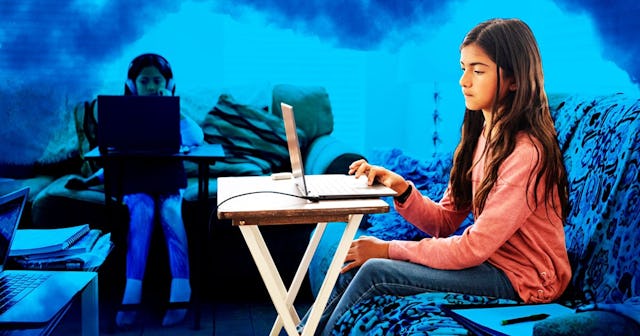Why Reopening Schools Has To Be A Top Priority

I have three kids, and they have all struggled with this whole homeschool thing in ways I didn’t expect. My son has struggled a lot with procrastination, while my middle daughter has struggled with confidence to do work on her own. Our youngest has been one huge focus problem. But she is six, so that should be expected.
Outside of academics, though, there has been a string of issues that I didn’t see coming. All three of them have been acting out in ways I’d never seen before, along with not sleeping well, and longing to once again connect with their friends, they have definitely had some struggles adjusting to these changes in their routine. And as it turns out, I’m not alone. According to a recent NPR survey, without school, children are experiencing nightmares, tantrums, regressions, grief, violent outbursts, exaggerated fear of strangers, and even suicidal thoughts.
Now naturally, schools were closed to help keep children, and our communities, safe from COVID-19. As difficult as it has been to suddenly be schooling my children from home, I support the school closures for the purpose of public health. I don’t want my children to be sent back to school until I feel confident that it can be done safely.
But what we are all left with now is this difficult tradeoff: keeping children home to prevent them from infection, while potentially damaging their mental health because they no longer have access to the social aspects that the school setting provides, along with the support of teachers and counselors that are set up to bolster emotional development.
Dr. Dimitri Christakis is the editor-in-chief of the journal JAMA Pediatrics. In a recent editorial, he argues that the risks to children’s learning, social-emotional development and mental health need to be better balanced with the risks of spreading the coronavirus. “The social-emotional needs of children to connect with other children in real time and space, whether it’s for physical activity, unstructured play or structured play, this is immensely important for young children in particular,” explained Dr. Christakis.
Mayur Kakade/Getty
It isn’t just academic mastery that is going to take a hit with schools closed.
Emotionally, children are also struggling. I think all parents have witnessed this on some level since the lockdown. I’ve seen a lot of people posting online about how their children need more attention at bedtime, for example, and frankly it makes sense. I’ve been reading a lot of additional stories to my two girls, and although they have their own rooms, they have been sharing a bed most nights, the two of them practically sleeping on top of each other for comfort. And my son, who I’d never seen actually call someone before school closed, has spent hours on the phone calling friends, seeking out some sort of social interaction and connection.
Unlike parents who have social media and partners and friends and family to discuss and process our new normal in the shadow of COVID-19, our children don’t have a lot of those outlets without school. In fact, they might not even have the words, so it seems to all be coming out a little sideways, in the form of sleepless nights, anxiety, and in some cases, nightmares.
It’s important to keep in mind, too, that some children have more to worry about than nightmares and a lack of social interaction. With schools closed and activities canceled, adults who are mandatory reporters, such as teachers and counselors, are less likely to catch wind of abuse or neglect. As a parent, this might be one of the hardest realities of school closings and extra curricular cancellations.
According to the New York Times, China recorded an uptick in domestic violence shortly after the pandemic started. So did the United Kingdom. Katie Ray-Jones, the chief executive officer of the National Domestic Violence Hotline, reported to The Times that there had actually been fewer calls in recent days, down from between 1,800 and 2,000 a day to approximately 1,700. Sadly, this is not because domestic violence isn’t happening less, but because it’s harder for victims to report it. In contrast, According to KUTV, the Salt Lake City Police Department reported seeing a 33% increase in calls to report domestic violence since Utah residents were advised to stay home to stop the spread of COVID-19.
The sad reality is we are all spending a lot of time in our homes right now, and for some children, home is the most dangerous place to be.
What this all adds up to is that reopening schools needs to be a top priority — not only for the sake of our children’s education, but also for their safety and emotional well being. These kids need their safe haven back.
However, opening schools leaves us all with the original questions: can schools be opened safely with the looming threat of COVID-19? The CDC released recommendations for reopening schools recently, and most educators are left scratching their heads, trying to figure out how educating children can be done while maintaining social distancing standards, along with rigorous disinfecting.
My wife works at our children’s school, and right now they are discussing a no sniffle policy. If a child has a stuffy nose, they will be sent home. Allergy season should be interesting!
In an interview with NPR about his editorial, Christakis says that experts from different backgrounds need to be consulted, so that the risks of reopening schools can be properly balanced with the risks of keeping them closed. What is ultimately being discussed by those experts is schools focusing on “need” when classes return in the fall.
Students with the highest educational needs, emotional needs, and those at the greatest risk of abuse in the home will be given priority when attending school. This makes sense.
How long this will last really depends on how long our lives are intertwined with a pandemic.
This article was originally published on